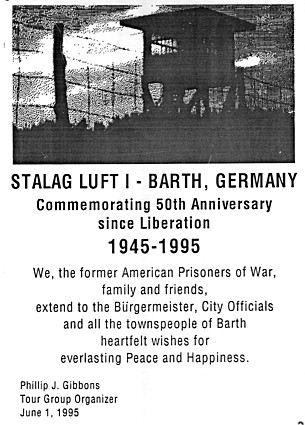


Cerro Gordo County Iowa
Part of the IaGenWeb Project
|
The Globe Gazette
Mason Cityans Among Group That Seized Prison Camp
EDITOR'S NOTE: Three Mason City and Clear Lake air force war prisoners known to have been at the Barth prison
camp, northern Germany, were among the 9,000 freed allied airmen 'in on the kill' as told in this remarkable story by
Lowell Bennett, International News Service correspondent, who had also been a prisoner at Barth.
Barth, Pomerania, May 1. (Delayed). - (INS) - Nine thousand allied air force war prisoners who were my companions in Stalag Luft No. 1 were liberated in time to go back to the war today and be in on the kill. These men, who for long months and years waited for this wonderful day, have taken more than 200 square miles of German territory, have linked up with the Russians and now are waiting to go home after their long exile. Total casualties of their entire operation so far is one man killed. During the past 12 hours they have seized their prison camp, captured 3 towns, an important air field and flak school and large quantities of equipment and fuel. Moreover, they have taken almost 2,000 German prisoners. A junction has been established with the Russian forces battering westward from Stettinand our joint victory in Pomerania is being riotously celebrated. Under the command of Col. Hubert Zemke, a fighter ace from Missoula, Mont., and a royal Canadian air force captain, the prisoners in this camp - the largest prison camp for allied air force officers in Europe - have made an important contribution to the final occupation of Germany. They also have made an important contribution to the establishment of first-class relations between the western and eastern allies on this northern front. The action began last night when the advancing Russian armies ahd reached the nearby sea base at Griefswald. Long-rehearsed operations got under way. We were fully prepared for such an eventuality. The "kriegies" (our abbreviation for the unwieldy tongue-twisting German word [Kriegesgefangenen] for war prisoners) captured the guard towers and the radio station. Scouts were dispatched in every direction and fully armed skirmish and picket lines were established. Expeditionary forces were organized to seize the entire area. Little opposition was encountered by the airmen, who, operating on the ground for the first time, disarmed the Germans they encountered and swiftly captured 50 vehicles, thousands of weapons and 3,000 gallons of fuel. Five neighboring prisoner of war camps and a concentration camp in the vicinity were liberated. Quickly afterward, the liberated airmen capture Barth's air base, where they seized 14 planes intact and 18 others which were damaged only slight. Our attempts to get in touch with the Russians at Stralsund and Greifswald by radio and telephone were unsuccessful. But this evening 2 of our scouts returned to camp with a Russian first lieutenant, Nich Karmytoff. This 22-year-old veteran red army infantry officer who had fought his way from Stalingrad to Barth, established the first Russian contact with the western allies in the Baltic. Complete liaison with the Russians was quickly established. At this writing, Col. Zemke's forces are in control of teh 175 square miles of Pomeranian territory and have taken almost 2,000 prisoners who they are making final arrangements to had over to the Russians and then go home. Paris has the American army had a more enthusiastic welcome. There was no formal parade by American units, though the Czech crowds loyally cheered every Yank motorcycle messenger, truckload of gasoline or jeep that drove past. But you could feel they were waiting for something - something they hadn't seen in almost 7 years. A Czech army marching through a Czech city under its own flags. Shortly before dusk word swept through the waiting thousands that a Czech army unit had entered the city. A few moments later the first car rolled into the city square. Three Czech girls in brightly colored native dresses waved the Czech flag at the crowd and they went wild. I have heard many crowd demonstrations, but none like the peculiar sound that rose from these oppressed people celebrating their first full day of liberation. The column contained only about 50 cars - a few ack ack guns, some Bren gun carriers, some civilian cars and a number of wheezy old derelict trucks decked with flowers and banners. Three German tanks could have destroyed it in 15 minutes. By as a symbol, that column was matchless. A cry burst from every throat as the first vehicle entered the parade area and as each car limped past the volume of sound grew greater. One truck that brought the loudest cheers had painted across its side: "From Dunkerquie to Pilsen to Prague." Many persons in the crowd knew that even the German tanks - remnants of forces that hadn't surrendered - were shooting up the center of their capital city. One truck broke down near the end of the parade, greatly embarrassing the driver, who was a veteran of Dunkerque. But the crowd immediately made him their favorite. By the time the parade was over they had covered his vehicle with flowers, and by nightfall it looked more like a curbside florist's stand than a truck.
NOTE: Stalag Luft 1 was located approximately 105 miles northwest of Berlin and two miles from the village of Barth
on a strip of barren land which extended into the
the Baltic Sea. According to the Stalag Luft 1 website (www.merkki.com/) Lt. Donald G. HARRER was housed in the South compound;
Lt. Melvin J. SPENCER and SSgt. Roy B. MARTIN Jr. were housed in North 1 compound.

Transcription and note by Sharon R. Becker, May of 2013
|
Return to Cerro Gordo County Honor Roll
Return to Military Index Page Return to Cerro Gordo Home Page